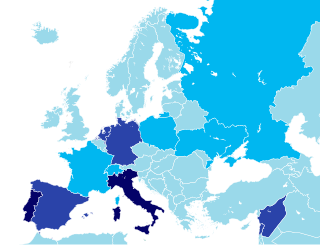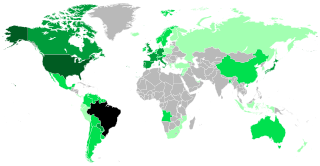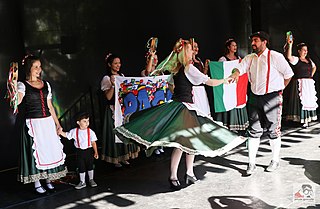Ukrainians constitute, as of 31 of March 2022, the second-largest foreign community residing in Portugal, after almost doubling from 27,200 to 52,000 as a consequence of the Ukrainian Refugee Crisis during the period of one month. [1] The Ukrainians retook the second place for the first time since 2012, when they numbered 44,074. [2] [3] Albeit contingent to the development of the 2022 Russian invasion of Ukraine, this ends a declining trend for Ukrainians residing in Portugal, from its maximum in 2002, as the largest immigrant community numbering 62,448, to fifth with 28,629 in 2020, further declining to 27,220 in 2021. [4] Part of this decline however is due to naturalizations - from 2008 to 2021, a total of 30925 Ukrainians became Portuguese citizens. [5]
Ukrainians began arriving in Portugal in the late 1990s, and there was a tremendous growth in the early years of the twenty-first century. In the initial phase, between 1999 and 2002, immigration was processed either in an organized manner, based on intermediaries, or through international networks of illegal recruitment of workers, disguised as travel agencies. The earliest immigrants entered the country with Schengen visas, valid throughout the Schengen Area, and remained undocumented until they were granted permanent permits. [4] [6] [7]
From 2004, following the decline in investment in major public works, the economic recession and improved mechanisms for controlling illegal immigration, many Ukrainians have left the country. [4]
Since 2009, the decline in the number of immigrants has steepened as a consequence of the economic crisis that has been occurring from 2008 on, and also due to the acquisition of Portuguese nationality by many Ukrainian citizens. [4] [6]
Initially, the intention of many Ukrainian immigrants was to remain in Portugal for short periods, and many of them left the country. However, many others ended up opting for a longer stay. Among these, many decided to settle permanently in Portugal, joining or forming their families in the country and seeking recognition of their academic and professional qualifications, aiming access to more skilled and better paid jobs. [4]
Although the initial migration flow was motivated by job search and was predominantly masculine, the female component in the Ukrainian community in Portugal has increased substantially during the following years, particularly for reasons related to family reunification. According to Census 2011, women represented 49.2% of the Ukrainian population resident in Portugal, while in 2001 they were only 18.6%.
The Ukrainian population in Portugal is relatively young compared to the native Portuguese population. The average age of Ukrainians residing in Portugal is 34, lower than that of native Portuguese, which is 42.1 years.
The educational levels of individuals of working age (15–64 years) are higher than those of Portuguese nationals. According to Census 2011, 23.3% of Ukrainians in Portugal had completed college education, and only 9.7% had an academic qualification lower than the 9th grade. These values contrast with the education levels of the native Portuguese population, which were 16.6% and 40.6%, respectively.
Also, according to the 2011 Census, 71.1% of the Ukrainian population was economically active and 59.2% were employed, while 47% of the Portuguese nationals were economically active and only 41% had jobs.
Most Ukrainians in Portugal work in low-skill and low wages jobs, particularly in cleaning services, construction, manufacturing industries, transport services, hotels and restaurants. However, according to a recent survey, it was found that some Ukrainian workers have achieved jobs that are more compatible with their academic and professional qualifications. [4]

Demographic features of the population of Portugal include population density, ethnicity, education level, health of the populace, economic status, religious affiliations and other aspects of the population.

The South Region of Brazil is one of the five regions of Brazil. It includes the states of Paraná, Rio Grande do Sul, and Santa Catarina, and covers 576,409.6 square kilometres (222,553.0 sq mi), being the smallest region of the country, occupying only about 6.76% of the territory of Brazil. Its whole area is smaller than that of the state of Minas Gerais, in Southeast Brazil, for example or the whole metropolitan France.
Latin Americans are the citizens of Latin American countries.

Immigration to Brazil is the movement to Brazil of foreign peoples to reside permanently. It should not be confused with the forcible bringing of people from Africa as slaves. Latin Europe accounted for four-fifths of the arrivals. This engendered a strikingly multicultural society. Yet over a few generations, Brazil absorbed these new populations in a manner that resembles the experience of the rest of the New World.

Immigration to Turkey is the process by which people migrate to Turkey to reside in the country. Many, but not all, become Turkish citizens. After the dissolution of the Ottoman Empire and following Turkish War of Independence, an exodus by the large portion of Turkish (Turkic) and Muslim peoples from the Balkans, Caucasus, Crimea, and Greece took refuge in present-day Turkey and moulded the country's fundamental features. Trends of immigration towards Turkey continue to this day, although the motives are more varied and are usually in line with the patterns of global immigration movements. Turkey's migrant crisis is a following period since the 2010s, characterized by high numbers of people arriving and settling in Turkey.

White Brazilians refers to Brazilian citizens who are considered or self-identify as "white", typically because of European or Levantine descent.
Portuguese Luxembourgers, also known as Luso-Luxembourgers, are the citizens or residents of Luxembourg whose ethnic origins lie in Portugal, including both Portuguese-born citizens with Luxembourg citizenship and Luxembourg-born citizens of Portuguese ancestry or citizenship.

Brazilians are the citizens of Brazil. A Brazilian can also be a person born abroad to a Brazilian parent or legal guardian as well as a person who acquired Brazilian citizenship. Brazil is a multiethnic society, which means that it is home to people of many ethnic origins, and there is no correlation between one's stock and their Brazilian identity.

Immigration to Europe has a long history, but increased substantially after World War II. Western European countries, especially, saw high growth in immigration post 1945, and many European nations today have sizeable immigrant populations, both of European and non-European origin. In contemporary globalization, migrations to Europe have accelerated in speed and scale. Over the last decades, there has been an increase in negative attitudes towards immigration, and many studies have emphasized marked differences in the strength of anti-immigrant attitudes among European countries.

Brazilian society is made up of a confluence of people of Indigenous, Portuguese, and African descent. Other major significant groups include Italians, Spaniards, Germans, Lebanese, and Japanese.

As of 2021, Portugal had 1,198,793 inhabitants that were born in a foreign country, out of 10,467,366 inhabitants, accounting for 11.5% of its total population.

Brazil had an official resident population of 203 million in 2022, according to IBGE. Brazil is the seventh most populous country in the world, and the second most populous in the Americas and Western Hemisphere.
Angolans in Portugal form the country's second-largest group of African migrants, after Cape Verdeans. In 2006, official statistics showed 28,854 legal Angolan residents in Portugal. However, this number is likely an underestimate of the true size of the community, as it does not count people of Angolan origin who hold Portuguese citizenship. In 2022 INE counted 31,614 Angolans living in Portugal.
European immigration to Brazil refers to the movement of European people to Brazil. It should not be confused with the colonisation of the country by the Portuguese.

The Citizen Card or CC is an identity card issued by the Portuguese government to its citizens. The card replaces several previous documents, including the Bilhete de Identidade, Social Security card, National Health Service card, Taxpayer card and voter registration card, in one secure card. The Citizen Card was first issued in the Azores in mid-2006.
Portuguese in the Netherlands are the citizens or residents of the Netherlands whose ethnic origins lie in Portugal.

Italian Brazilians are Brazilians of full or partial Italian descent, whose ancestors were Italians who emigrated to Brazil during the Italian diaspora, or more recent Italian-born people who've settled in Brazil. Italian Brazilians are the largest number of people with full or partial Italian ancestry outside Italy, with São Paulo being the most populous city with Italian ancestry in the world. Nowadays, it is possible to find millions of descendants of Italians, from the southeastern state of Minas Gerais to the southernmost state of Rio Grande do Sul, with the majority living in São Paulo state. Small southern Brazilian towns, such as Nova Veneza, have as much as 95% of their population of Italian descent.

According to the Japanese Ministry of Justice, the number of foreign residents in Japan has steadily increased in the post Second World War period, and the number of foreign residents was more than 2.76 million at the end of 2022. Being a country with a total estimated population of 125.57 million in 2020, the resident foreign population in Japan amounts to approximately 2.29% of the total population.

Portugal – South Africa relations refer to the current and historical relationship between Portugal and South Africa. Nowadays the two countries have solid relations, with South Africa representing a major partner for Portugal amongst AU members.
Uniquely, the Norwegian archipelago of Svalbard, located in the High Arctic, is an entirely visa-free zone. However, travelers who have a visa requirement to enter mainland Norway/the Schengen area must have a Schengen visa if they travel via mainland Norway/the Schengen area. This must be a double-entry visa so they can return to mainland Norway/the Schengen area.